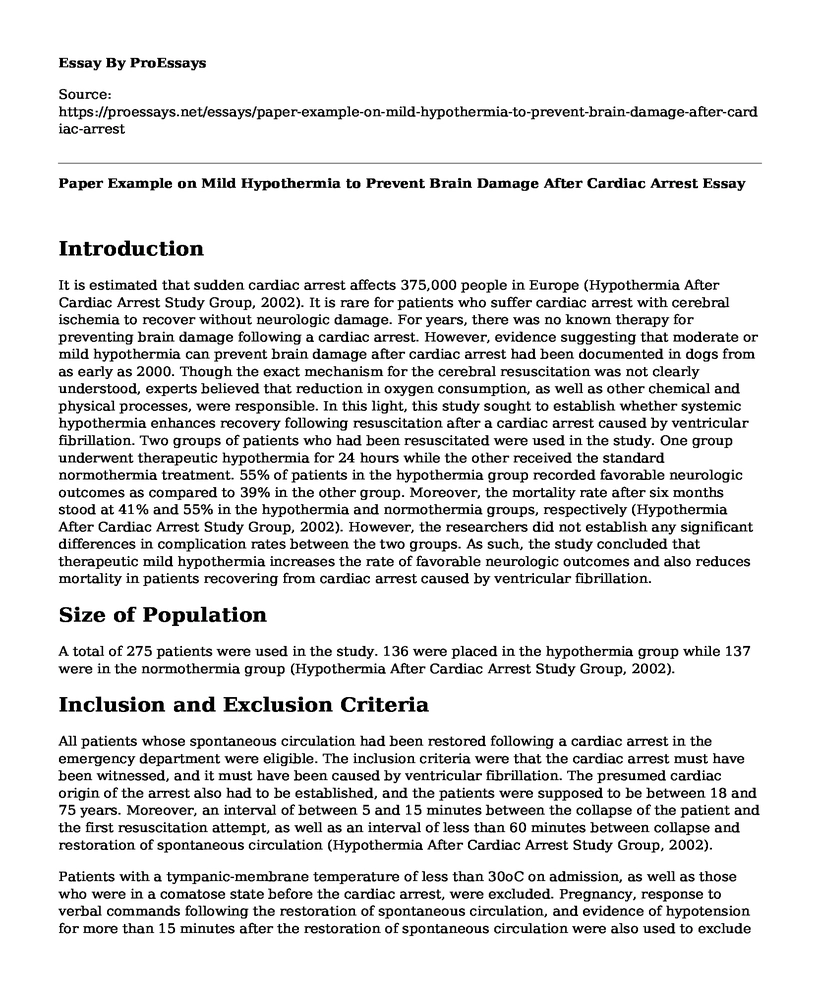Introduction
It is estimated that sudden cardiac arrest affects 375,000 people in Europe (Hypothermia After Cardiac Arrest Study Group, 2002). It is rare for patients who suffer cardiac arrest with cerebral ischemia to recover without neurologic damage. For years, there was no known therapy for preventing brain damage following a cardiac arrest. However, evidence suggesting that moderate or mild hypothermia can prevent brain damage after cardiac arrest had been documented in dogs from as early as 2000. Though the exact mechanism for the cerebral resuscitation was not clearly understood, experts believed that reduction in oxygen consumption, as well as other chemical and physical processes, were responsible. In this light, this study sought to establish whether systemic hypothermia enhances recovery following resuscitation after a cardiac arrest caused by ventricular fibrillation. Two groups of patients who had been resuscitated were used in the study. One group underwent therapeutic hypothermia for 24 hours while the other received the standard normothermia treatment. 55% of patients in the hypothermia group recorded favorable neurologic outcomes as compared to 39% in the other group. Moreover, the mortality rate after six months stood at 41% and 55% in the hypothermia and normothermia groups, respectively (Hypothermia After Cardiac Arrest Study Group, 2002). However, the researchers did not establish any significant differences in complication rates between the two groups. As such, the study concluded that therapeutic mild hypothermia increases the rate of favorable neurologic outcomes and also reduces mortality in patients recovering from cardiac arrest caused by ventricular fibrillation.
Size of Population
A total of 275 patients were used in the study. 136 were placed in the hypothermia group while 137 were in the normothermia group (Hypothermia After Cardiac Arrest Study Group, 2002).
Inclusion and Exclusion Criteria
All patients whose spontaneous circulation had been restored following a cardiac arrest in the emergency department were eligible. The inclusion criteria were that the cardiac arrest must have been witnessed, and it must have been caused by ventricular fibrillation. The presumed cardiac origin of the arrest also had to be established, and the patients were supposed to be between 18 and 75 years. Moreover, an interval of between 5 and 15 minutes between the collapse of the patient and the first resuscitation attempt, as well as an interval of less than 60 minutes between collapse and restoration of spontaneous circulation (Hypothermia After Cardiac Arrest Study Group, 2002).
Patients with a tympanic-membrane temperature of less than 30oC on admission, as well as those who were in a comatose state before the cardiac arrest, were excluded. Pregnancy, response to verbal commands following the restoration of spontaneous circulation, and evidence of hypotension for more than 15 minutes after the restoration of spontaneous circulation were also used to exclude patients. Other factors considered in the exclusion criteria include evidence of hypoxia for more than 15 minutes following the restoration of spontaneous circulation, presence of terminal illness before the arrest, ease of follow-up, pre-existing coagulopathy, among others (Hypothermia After Cardiac Arrest Study Group, 2002).
Method of Data Collection
The Utstein style was used to record individual patients' data on cardiac arrest. Laboratory tests were also carried out at the baseline, as well as at 12 and 48 hours after cardiac, and also as clinically indicated. The risk factors for unfavorable outcomes were also documented.
Conclusion
The study provided great insight that supported more research into the effectiveness of hypothermia treatment to mitigate neurologic damage after sudden cardiac arrest. Other studies have built on it and confirmed the efficacy of mild therapeutic hypothermia, bringing about a massive advancement in the clinical management of sudden cardiac arrest. Over the last decade, mild induced hypothermia has become the standard intervention in cardiac arrest patients (Donnino, et al., 2016). However, cardiac arrest remains a leading cause of mortality and morbidity, and hence more research is needed to develop more interventions.
References
Donnino, M. W., Anderson, L. W., Berg, K. M., Reynolds, J. C., Nolan, J. P., Morley, P. T., . . . Soar, J. (2016). Temperature management after cardiac arrest: an advisory statement by the advanced life support task force of the international liaison committee on resuscitation and the American heart association emergency cardiovascular care committee and the council o. Resuscitation, 98, 97-104. Retrieved from https://www.sciencedirect.com/science/article/pii/S0300957215008175
Hypothermia After Cardiac Arrest Study Group. (2002). Mild therapeutic hypothermia to improve the neurologic outcome after cardiac arrest. New England Journal of Medicine, 346(8), 549-556. Retrieved from https://www.nejm.org/doi/pdf/10.1056/nejmoa012689
Cite this page
Paper Example on Mild Hypothermia to Prevent Brain Damage After Cardiac Arrest. (2023, May 03). Retrieved from https://proessays.net/essays/paper-example-on-mild-hypothermia-to-prevent-brain-damage-after-cardiac-arrest
If you are the original author of this essay and no longer wish to have it published on the ProEssays website, please click below to request its removal:
- Sociology Paper Sample: Disabled People's Rights in St. Vincent and the Grenadines
- Otitis Media Paper Example
- Pathophysiology Diagnosis Paper Example
- U.S Pharmaceutical Industry - Assignment Example
- Research Paper on Obesity Among African Americans in Texas
- Essay Sample on Vasectomy: Making the Difficult Decision of Permanent Sterilization
- Free Research Paper Sample on Early Childhood Education During the COVID-19 Pandemic: Anthropology and Education







